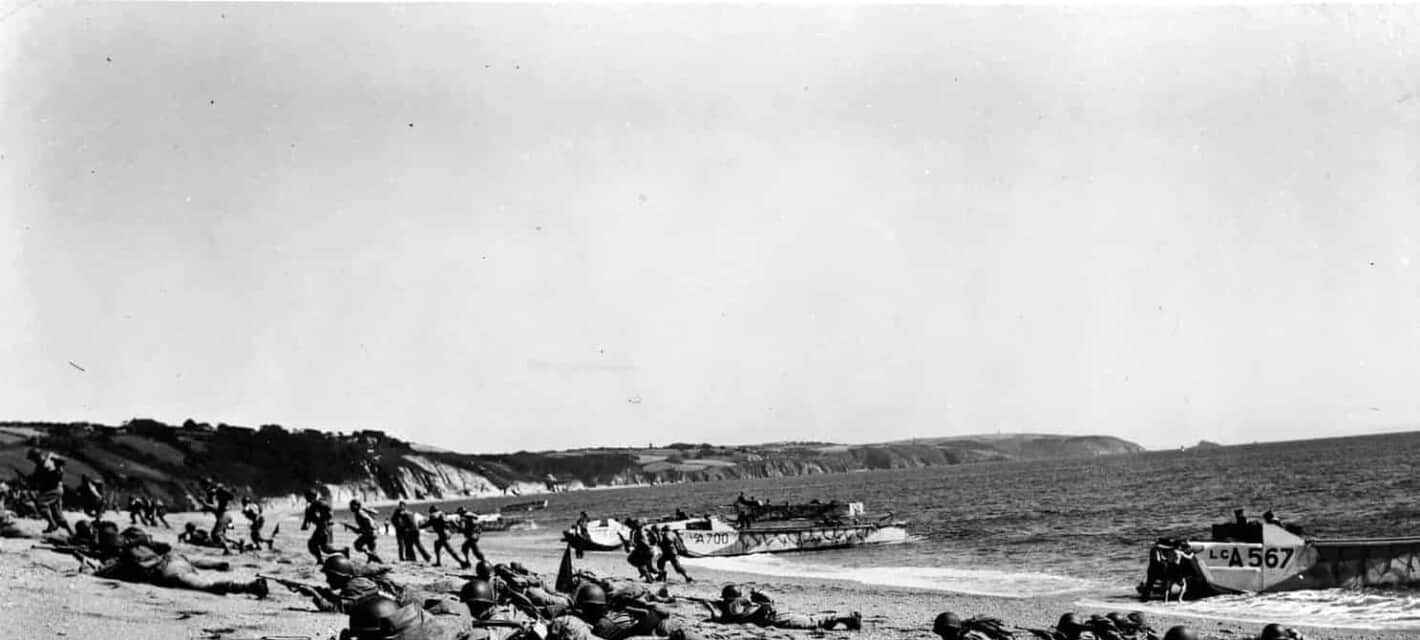The D-Day landing at Normandy on June 6, 1944, was one of the most pivotal events of World War II, but it was preceded by a disastrous rehearsal just over five weeks earlier. The ‘practice’ mission was specifically for the landing at Utah Beach. The disaster at Lyme Bay, off the coast of Devon, England, resulted in the deaths of at least 749 soldiers, a greater loss than that suffered by the Allies during the real Utah landing.
A Secret Dress Rehearsal
The D-Day landing was in the works for quite some time, and in late 1943, the British set up a training ground in Devon at Slapton Sands which was chosen for its similarity to Utah Beach. At this time, approximately 3,000 local residents were told they had six weeks to leave their homes; no explanation was given. In spring 1944, tens of thousands of American soldiers arrived and settled in Devon in preparation for the crucial event to come.

Slapton Sands was chosen as the venue for the rehearsal because they were long, wide and almost identical to the beaches of Normandy. The mission was given the name Operation Tiger and involved placing landing boats in the English Channel and ensuring they simulated a water landing on Devon’s beaches. The Allied commander, Dwight D. Eisenhower, was in charge of proceedings and he wanted to place the men in the rough areas of the channels so they could experience seasickness and realism.
The operation also included tank landing craft along with the ships. The idea was to have gunfire and shellfire to simulate what the Allies would face when they landed in France. In order to keep the mission a secret, Allied commanders shared no information with their troops.
Although there had been other landing rehearsals, Operation Tiger was the largest of the lot. It was due to take place from 22-30 April 1944 and was designed to cover all aspects of the invasion. A total of 30,000 troops were involved and work on the project was fast and furious. The Allies constructed fake enemy positions and concrete pillboxes while each assault team included 30 soldiers armed with an impressive arsenal including machine guns, flamethrowers, bazookas, and mortars.

An Unexpected Battle
The initial landing went smoothly enough but disaster struck shortly after midnight on April 28. Convoy T-4, which included eight LSTs (nicknamed Long Slow Targets by their crews), sailed into the English Channel to continue the rehearsal. Unfortunately, there was a German fleet patrolling the area, and it picked up the Allied vessels on its radar. Recognizing that they had a sitting duck to aim for, the Germans launched a rapid attack and fired torpedoes at the helpless enemy.
There was a total of nine German E-Boats involved in the attack which became known as the Battle of Lyme Bay. One of the worst aspects of the incident was that the casualties could have been significantly reduced only for a simple typographical error in orders. The result was that the British naval headquarters ashore were on a different radio frequency to the Americans in the water. As a result, the ships near Lyme Bay had no idea of the danger until it hit them.
Although shore batteries knew about the German boats, they were under strict orders not to open fire and reveal their positions. An unfortunate accident earlier in the operation ensured the convoy was an easy target. There were supposed to be two ships protecting the convoy, but the HMS Scimitar had suffered damage after an accident with an LST and was not available. As a result, the HMS Azalea led the ships in a straight line, a formation that was criticized for making the convoy an easy target.
The Azalea spotted the E-Boats but assumed the landing craft knew of their existence so he did not inform them of the German presence on the water. It was only when the attack started that the lack of security around the convoy became known. HMS Saladin was dispatched a few minutes after the attack began but it was too late.
Three ships were hit in the initial attack; LST 507 caught fire and had to be abandoned, LST 531 suffered a direct hit and quickly sank while LST 289 was also hit and in flame but managed to make it to the shore. The landing craft was attacked so suddenly that there was no time to launch life rafts. Allied commanders wanted to avoid further direct hits, so they ordered the ships to split up. However, it was a death sentence to the men already in the water as they were left to die. According to eyewitness accounts, soldiers were weighed down by their gear and sank. Others had put their lifejackets on incorrectly by wearing them around their waists instead of their armpits.
According to survivors, you could “walk to the beach on the dead bodies.” Although estimates vary, it’s likely that over 700 men died during the attack. Although the Azalea fired upon the enemy, the German ships emerged from the battle unscathed. If the Allies thought things couldn’t get any worse, they were sorely mistaken.

